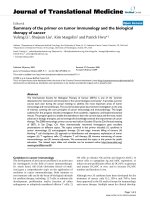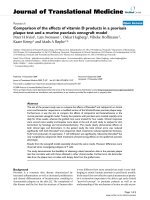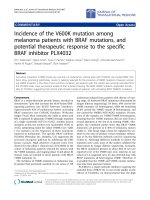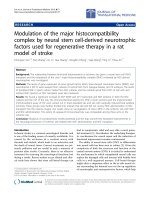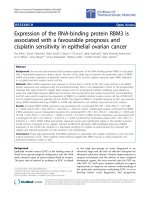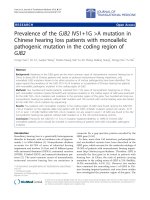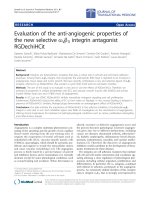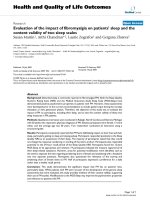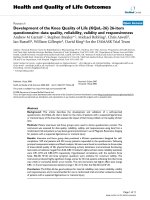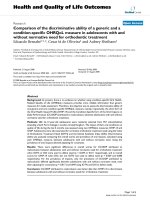Báo cáo hóa học: " Selection of Recombinant MVA by Rescue of the Essential D4R Gene" docx
Bạn đang xem bản rút gọn của tài liệu. Xem và tải ngay bản đầy đủ của tài liệu tại đây (1.12 MB, 25 trang )
This Provisional PDF corresponds to the article as it appeared upon acceptance. Fully formatted
PDF and full text (HTML) versions will be made available soon.
Selection of Recombinant MVA by Rescue of the Essential D4R Gene
Virology Journal 2011, 8:529 doi:10.1186/1743-422X-8-529
Patricia S Ricci ()
Birgit Schafer ()
Thomas R Kreil ()
Falko G Falkner ()
Georg W Holzer ()
ISSN 1743-422X
Article type Methodology
Submission date 14 September 2011
Acceptance date 12 December 2011
Publication date 12 December 2011
Article URL />This peer-reviewed article was published immediately upon acceptance. It can be downloaded,
printed and distributed freely for any purposes (see copyright notice below).
Articles in Virology Journal are listed in PubMed and archived at PubMed Central.
For information about publishing your research in Virology Journal or any BioMed Central journal, go
to
/>For information about other BioMed Central publications go to
/>Virology Journal
© 2011 Ricci et al. ; licensee BioMed Central Ltd.
This is an open access article distributed under the terms of the Creative Commons Attribution License ( />which permits unrestricted use, distribution, and reproduction in any medium, provided the original work is properly cited.
Selection of recombinant MVA by rescue of the
essential D4R gene
ArticleCategory :
Methodology
ArticleHistory :
Received: 14-Sept-2011; Accepted: 15-Nov-2011
ArticleCopyright
:
© 2011 Ricci et al; licensee BioMed Central Ltd. This is an Open Access
article distributed under the terms of the Creative Commons Attribution
License ( which permits
unrestricted use, distribution, and reproduction in any medium, provided
the original work is properly cited.
Patricia S Ricci,
†Aff1
Email:
Birgit Schäfer,
†Aff1
Email:
Thomas R Kreil,
Aff2
Email:
Falko G Falkner,
Aff1
Email:
Georg W Holzer,
Aff1
Corresponding Affiliation: Aff1
Phone: +43-1-201004957
Fax: +43-1-201004000
Email:
†
Contributed equally
Aff1
Baxter BioScience, Biomedical Research Center, Uferstrasse 15, 2304
Orth an der Donau, Austria
Aff2
Baxter BioScience, 1221 Vienna, Austria
Abstract
Modified vaccinia virus Ankara (MVA) has become a promising vaccine vector due to its
immunogenicity and its proven safety in humans. As a general approach for stringent and rapid
selection of recombinant MVA, we assessed marker rescue of the essential viral D4R gene in an
engineered deletion mutant that is fully replication defective in wild-type cells. Recombinant,
replicating virus was obtained by re-introduction of the deleted viral gene as a dominant
selection marker into the deletion mutant.
MeSH Keywords
Recombinant vaccines, Uracil-DNA glycosylase, Vaccinia virus, Cell Line, Transformed,
Defective viruses/genetics, Defective viruses/growth & development
Introduction
Modified vaccinia virus Ankara (MVA) was developed as a safer smallpox vaccine during the
smallpox eradication campaign [1]. For this purpose, vaccinia strain Ankara was passaged more
than 500 times in primary chicken embryo fibroblast cells (CEF). Replication of MVA is almost
completely restricted to avian cells, and the virus is strongly attenuated in vivo. The excellent
safety record of this strain was established in vaccination campaigns in the 1970’s, when over
120,000 humans including immune suppressed individuals were immunized [2,3]. Safety of
MVA as a smallpox vaccine has also been addressed by others in clinical studies [4-6].
The attenuated phenotype is the consequence of multiple changes in the viral genome. Six major
deletions and numerous other mutations including small deletions, point mutations and insertions
relative to the parental strain were mapped [7,8]. MVA has been intensively studied as a vector
for use in recombinant live vaccines [9]. MVA-based live vaccines have already been under
evaluation in numerous clinical trials, recently for instance for HIV [10,11], influenza [12], and
against smallpox [5]. Safety was also demonstrated with a recombinant MVA-based cancer
vaccine (TroVax) in clinical studies [13].
Recombinant MVA are usually generated by homologous recombination techniques [14,15],
followed by repeated rounds of plaque purification under selective conditions. Methods for
clonal selection have been established previously for vaccinia virus in general, including
dominant E.coli gpt marker selection [16] and lacZ color screening [17], and are equally used for
work with MVA. Other techniques for the isolation of recombinant vaccinia virus (VV), such as
tk
-
selection, cannot be applied to MVA due to its restriction to a few cell types. Specifically for
MVA, certain host range selection methods have been developed that make use of the genetic
basis of the growth restrictions of MVA. For example, introduction of the VV gene K1L as a
marker which is naturally deleted in MVA, extends the host range to rabbit kidney cells [18].
However, there might be regulatory concerns that selection markers can change the attenuated
phenotype of MVA thereby impairing the well-established safety profile of MVA. For instance,
the VV K1L gene encodes viral functions that impair important anti-viral defense mechanisms of
the infected host. The K1L gene product suppresses activation of the transcription factor NF-κB
[19]. More recently, it was shown that K1L –alongside with C7L- is also involved in preventing
RNA-activated protein kinase (PNK) -dependent and -independent shut-off of protein synthesis
by the infected host [20]. In MVA, the lack of a functional K1L gene enables early-phase PNK-
mediated host responses possibly contributing to both the impairment of viral replication and the
stimulation of the immune response [21].
Generally, plaque purification procedures are more difficult with MVA compared to replicating
vaccinia strains, because MVA work is limited to a narrow range of cell substrates. Classically,
MVA is grown and purified on primary CEF. Plaque formation on these cells is not as clear as
with most permanent cell lines, and the work depends on cell supply of constant quality. To
compensate for these shortcomings, additional detection methods such as immunostaining have
been applied for MVA plaque isolation on CEF [22].
An elegant and stringent selection approach is the rescue of virus with wild-type (wt) -like
growth properties by re-introduction of a previously deleted viral function. For MVA, deletion of
the non-essential genes E3L and F13L, respectively [23,24] resulted in viruses of altered plaque
properties or narrowed host range, allowing the selection of recombinants after re-introduction of
these genes and rescue of the wild-type phenotype.
While the latter selection methods are based on non-essential host range genes, we now
attempted a rescue selection procedure by use of a parental MVA that lacks an essential function
and that is entirely growth incompetent on wild-type cells. Deletion of the essential gene D4R
from vaccinia virus and complementation of the deleted viral function by an engineered
complementing cell line has been described earlier [25]. The vaccinia virus gene D4R encodes
the protein uracil DNA glycosylase, which catalyzes the removal of uracil residues from double-
stranded DNA, and which is an indispensable component of the vaccinia DNA polymerase
complex [26]. Recently, knock-out of the D4R gene has been applied to MVA with the purpose
of reduced vector antigen expression in recombinant vaccines [27]. Growth of the knock-out
virus requires a permanent cell-line that may be engineered to complement the viral function. For
MVA which is largely restricted to avian cells, the avian cell line DF-1 was found to be
appropriate for this task. The cell line DF-1 had been created after spontaneous immortalization
of CEF and was initially investigated for the work with avian retroviruses [28]. Because D4R-
based dominant host range selection was found to provide a powerful selection method for
replicating vaccinia recombinants [29], it was now attempted to adopt this technique also to
MVA.
Material and methods
Cell lines and viruses
The African green monkey cell line Vero (ATCC CCL-81), and the chicken embryo fibroblast
cell line DF-1 (ATCC CCL-12203) were grown in DMEM (Biochrom) containing 5% of fetal
calf serum (PAA), non-essential amino acids (NEAA) and Pen/Strep (Lonza). Primary chicken
embryo cells (CEF) were isolated from 12 day old chicken embryos and grown in Med-199
(Gibco) containing 5% of fetal calf serum, Pen/Strep and NEAA.
Construction of the D4R defective vaccinia virus Lister (dVV-L) is described elsewhere [30].
Modified vaccinia virus Ankara (Isolate MVA74 LVD6) was obtained from Dr. Bernard Moss,
National Institute of Allergy and Infectious Diseases. This MVA isolate originates from three
rounds of plaque purifications of MVA passage 572 [1] and was frozen prior to the emergence of
bovine spongiform encephalopathy. The virus rMVA-YF/d3 that carries the YFV prME cassette
in the genomic del3 region is described elsewhere [31].
Retroviral transduction of DF-1 cells
The D4R gene was introduced into DF-1 cells by transduction with a retroviral vector that had
been derived from the commercially available vector pLXSN, Invitrogen [32]. Retroviral vector
particles were generated in Vero cells by simultaneous transfection with the packaging plasmids
pGAGPOL-gpt [33] and pALF (both kindly provided by W. Günzburg, University of Veterinary
Medicine Vienna), and the vector plasmid pLXSN-D4R [34]. The plasmids (7 µg each) were
transfected into subconfluent Vero cells by calcium phosphate transfection as described before
[35]. After 2 days, the supernatant was collected, supplemented with 4 µg/ml polybrene and
filtered through 0.45 µm filters (VWR). The retroviral vector containing supernatant was diluted
1:10 and used to infect DF-1 cells of passage 31. After 4 days, cells were split into medium
containing 100 µg/ml G418 (Invitrogen). Media changes were made every 4 days until cell foci
could be picked and expanded under continued selective pressure. In passage 38, a master cell
bank of cDF-1 was frozen, of which one aliquot was thawed and expanded for a working cell
bank. The working cell bank corresponds to passage 41 of the parental DF-1 line.
Construction of plasmids
pDM-Zgpt
The plasmid pDM-Zgpt contains the lacZ/gpt double marker cassette flanked by genomic
sequences of MVA to drive homlogous recombination into the viral D4R locus. First, the MVA
sequences, that flank the D4R gene at either side, were amplified by PCR, using MVA genomic
DNA as the template. The left flanking region of the D4R gene was amplified using the forward
primer 5′-CAT TGT TAA CTG TGA GCT ACT GTA GGT G-3′ and the reverse primer 5′-CTC
GAG GTC GAC AAG CTT CCA TGG TTA TAT CAA ATT AGA TAC C-3′. For cloning
purposes, a HpaI restriction site (restriction sites underlined) was introduced into the forward
primer. The reverse primer contained XhoI, SalI, HindIII and NcoI as a future multiple cloning
site. The MVA D4R right flank was generated by PCR with the forward primer 5′-GTC GAC
CTC GAG GGC GCC GCG GCC GCT GCT TTA GTG AAA TTT TAA C-3′ containing the
restriction sites SalI, XhoI, EheI, NotI, and the reverse primer 5′-CGT AAG CGG AAG AGC
ACT ATT GTT GTT CAT ATC CAC G-3′. The PCR products were sequentially cloned into
pPCR-ScriptAmpSK(+) (Stratagene). In the resulting construct pDM, the MVA D4R flanks (left
flank: 836 bp; right flank: 685 bp) frame a multiple cloning site. Next, the lacZ/gpt double
marker cassette from pDW-2 [29] was cloned via HindIII/SalI restriction into pDM to generate
pDM-Zgpt.
pDM-D4R
The MVA D4R gene was amplified by PCR from MVA genomic DNA with the forward primer
5′-AGG CGT TTG TAT TCG CTT GG-3′, and the reverse primer 5′-ACA CCA TGG GCT
AGC TCG CGA TTA ATA AAT AAA CCC TTG AGC C-3′. The forward primer binds to the
genomic MVA DNA upstream of an Eco105I site that is located 27 bp outside of the the D4R
gene. The reverse primer contained the restriction sites NcoI, NheI and NruI for a MCS
downstream of the D4R gene. Using the restriction sites Eco105I and NcoI, the PCR product was
cloned into pDM resulting in pDM-D4R.
pDM-D4R-YF
To construct the plasmid for integration of the YFV prME into the D4R/D5R locus, the yellow
fever prME gene cassette was excised from plasmid pd3-YFprMEco and cloned into pDM-D4R,
using the restriction sites NheI and SalI. The resulting plasmid pDM-D4R-YF contains the YFV
prME expression cassette downstream of the D4R gene [31].
Generation of viruses
Recombinant virus was generated by homologous recombination [15]. Confluent monolayers of
the indicated cell types were infected/transfected according to the procedures essentially
described before [34].
dMVA-ZG
Infection/transfection with MVA-wt and the plasmid pDM-Zgpt was done in CEF. Recombinant
MVA was selected by seven rounds of plaque purification with gpt selection [16] and lacZ
screening [17] in the D4R complementing cell line cDF-1. A plaque isolate that did not show any
growth on wt DF-1 cells was expanded in cDF-1 and a purified virus stock was prepared as
previously described [36]. The resulting defective MVA was termed dMVA-ZG.
rMVA-YF/D4
Wild type DF-1 cells were infected with dMVA-ZG, and the plasmid pDM-D4R-YF was used
for transfection. Plaque purification and amplification were carried out in wild type DF-1 cells.
Characterization of defective MVA by PCR
PCR was performed to confirm the expected genomic structure of the defective virus dMVA-ZG
and to test for contamination with residual wild-type MVA. For this purpose, sucrose cushion
purified dMVA-ZG stock was used. For spike controls, 1%, 0.1%, 0.01% and 0.001% MVA-wt
were added to dMVA-ZG samples. After digestion with 0.5 µg/µl proteinase K (Sigma) for 3 hrs
at 56°C and 2 hrs at 95°C, 1 µl samples corresponding to 1 × 10
5
pfu were subjected to PCR.
The reaction was carried out with the primers 5′-ACC TTC CAA CTG TGG ATA CTC TG-3′
and 5′-TCG AAT GAA ATA AAC CCT GGT-3′ resulting in a PCR signal of 2430 bp with
MVA-wt, and of 5624 bp with dMVA-ZG as a template.
Growth experiments with MVA and vaccinia virus
Confluent cells cultivated in 6-well plates were infected with 5 × 10
4
tissue culture infectious
doses 50% (TCID
50
) of the respective MVA or vaccinia virus, followed by media change after 1
h. Cells were kept in a CO
2
incubator at 37°C. At the respective time points post infection, cells
were scraped into the medium and disrupted by three cycles of freeze/thaw and ultrasonication.
The virus titer was determined by TCID
50
assay, and the output/input ratio was calculated. MVA
was grown and titrated on the cell line DF-1, and dMVA-ZG on the complementing cell line
cDF-1.
Determination of infectious titers
Infectious titers were assayed by TCID
50
assay. Serial ten-fold dilutions of specimen were
applied to CEF in 96-well plates, and virus induced cytopathic effect was evaluated by light
microscopy after 5–7 days of incubation at 37°C in a CO
2
atmosphere. Viral titers were
calculated according to the formula of Spearman and Kaerber [37] and were expressed as
TCID
50
/ml. One TCID
50
/ml corresponds to about 0.5 plaque forming unit (pfu), as determined in
a series of parallel measurements.
Double immunostaining
Plaques of MVA that express YFV prME antigen were identified by double immunostaining.
cDF-1 cells were infected with recombinant YF prME-expressing MVA for a period of 4 days,
and were then fixed with methanol/acetone (1:1). To detect plaques of YFV prME expressers, a
guinea pig antiserum against YFV-17D (Lot # 070824/T4, Baxter) was used. Goat anti-guinea
pig horseradish peroxidase-conjugated IgG (Jackson ImmunoResearch Laboratories, Inc.) was
used as a secondary antibody. Plaques were visualized with diaminobenzidine (DAB) solutions
including nickel (Vector Laboratories), resulting in black plaques. In a subsequent round,
plaques were additionally stained for vaccinia antigens, using a polyclonal rabbit anti-vaccinia
virus serum (Lot no. VVSKP26012006, Baxter). In this case, the secondary antibody was a goat
anti-rabbit peroxidase-conjugated IgG (Jackson Inc), and staining was done with DAB solution
without nickel, resulting in brown plaques, essentially as described earlier [38].
Growth assay of defective MVA for replicating contaminants
To detect replication competent virus in defective virus stocks, ten 175 cm
2
cell culture flasks of
confluent DF-1 cells were infected with a total of 2 × 10
6
pfu (moi = 0.05) of dMVA-ZG. In
parallel cell culture flasks were infected with 100 pfu wild-type MVA or with a mixture of 2 ×
10
6
pfu dMVA-ZG and 100 pfu wild-type MVA to control the sensitivity of detection.
Uninfected DF-1 cells served as a negative control. Five days post infection plaques of residual
replication competent virus were visualized by crystal violet staining.
Western blotting
Whole cell lysates were prepared from 5 × 10
6
infected cells by three cycles of freezing/thawing,
followed by ultrasonication and denaturation in protein loading buffer (Fermentas). Aliquots
corresponding to 1 × 10
5
cells were resolved by 12% polyacrylamide gel electrophoresis.
Blotting was performed essentially as described previously [39]. For detection, a polyclonal
guinea pig antiserum (Lot # 070824/T4, Baxter) against YFV-17D, and anti-guinea pig alkaline
phosphatase-conjugated immunoglobulin (Sigma) as the second antibody, were used.
Isolation of genomic DNA and real-time PCR
Recombinant virus plaques were picked and suspended in 500 µl DMEM, and used to infect
cDF-1 cells in 6-well plates to amplify the recombinant virus and potential residual parental
dMVA in the stocks. As controls, cells were infected in parallel with the parental dMVA-ZG,
wild-type MVA and rMVA-YF/del3. After 5 days, infected cells were harvested, and genomic
DNA was isolated using DNeasy kit (Quiagen Inc.). Aliquots corresponding to 0.4% of the 1 ml
harvest from a 6-well were used as template in quantitative PCR reactions. Real-time PCR was
performed with 2 µl of genomic template DNA in a total volume of 20 µl using Taqman gene
expression master mix (Applied BioSystem), and primers and probes at a final concentration of
900 nM and 200 nM, respectively, using a StepOnePlus real time PCR system (ABI, 4376598).
For amplification of the individual genomic targets, the following primer—probe sets were used:
YFV prME-specific: FWD (5′-TGA TGC AGG TCA AAG TGT CTA AGG-3′), RWD (5′-
TGT TGA TGG CGG CTG TCA-3′); and Probe (5′-6FAM-CTG CCG GAT CCC CGT-
MGB-3′).
LacZ-specific: FWD (5′-ATT CAG GCT GCG CAA CTG TT-3′), RWD (5′-CAG CAC ATC
CCC CTT TCG-3′), and Probe (5′-6FAMAAG GGC GAT CGG TGC G-MGB-3′).
MVA 173R gene-specific: FWD (5′-GCA ACG GCG AAA CAA AAT ATT T-3′), RWD (5′-
ATT AGG ACA CGT AAC AGT ATC ATT CCA-3′), and Probe (5′-6FAM-TTG CGA AGA
AAA AAA TGG AA-MGB-3′).
Specific for plasmid DNA (Amp
r
gene): FWD (5′-CCA ACG ATC AAG GCG AGT TAC-
3′), qPCRVVamp-RWD (5′-CCG AAG GAG CTA ACC GCT TT-3′), and Probe (5′-6FAM-
TGA TCC CCC ATG TTG TG-MGB-3′).
To generate standard curves for determination of genomic equivalents, plasmids containing
Amp
r
-, lacZ and 173R sequences and a plasmid containing the YFV prME gene, were used in
ten-fold dilutions ranging from 1 × 10
8
to 1 × 10
3
DNA copies.
Results and discussion
Generation of the D4R complementing cell line cDF-1
Traditionally, MVA is propagated in primary CEF. In order to propagate the D4R-deleted MVA
that should serve as the parental strain for the intended selection procedure, a stably D4R-
expressing cell line was required. Ideally, the cell line should be non-tumorigenic and of avian
origin to allow the growth of MVA. For technical reasons, formation of clear MVA plaques is a
desirable general characteristic of the cell line of choice. To evaluate the cell line DF-1 for the
intended selection of recombinant replicating MVA, we assessed it for propagation of MVA
using primary CEF as a reference. In DF-1, a maximal MVA titer (about 7.4 log10 TCID
50
) was
reached as early as day 1. In plaque assays, MVA formed confined, circular plaques on DF-1
cells, making this cell line useful for the intended plaque purification of defective MVA.
The D4R complementing DF-1 based cell line was generated by retroviral transduction
analogous to a Vero-based complementing cell line described previously [34]. We used the D4R-
defective vaccinia virus Lister dVV-L [30] to screen for the cell clone that complemented most
efficiently the lacking viral function. The DF-1 cell clone #4A allowed amplification of the
defective vaccinia virus to the highest titers (data not shown), and was therefore further
expanded to obtain the cell line cDF-1.
Generation of a non-replicating parental virus
In order to knock out the essential vaccinia gene D4R, and to prepare a growth defective MVA, a
recombination plasmid (pDM-Zgpt) was constructed that contains the MVA genomic regions
that naturally flank the MVA D4R gene with the D4R sequences being deleted. The D4R gene
and its natural promoter were replaced by a marker cassette encoding the E.coli lacZ and gpt
genes (Figure 1a). After infection with MVA and transfection with the plasmid pDM-Zgpt, the
intended recombinant virus dMVA-ZG was isolated by repeated rounds of plaque purification
under gpt selection combined with blue plaque screening in the complementing cell line cDF-1.
The virus dMVA-ZG did not form plaques on wt DF-1 cells (Figure 2c), while it readily formed
plaques on the complementing cell line cDF-1 (Figure 2a). Plaque formation by dMVA-ZG was
also absent in CEF (not shown). As expected, the MVA-wt strain grew both on cDF-1 and DF-1
cells (Figure 2b, d). On cDF-1 cells, the defective virus propagated similar to MVA-wt, while in
the absence of complementation, titers decreased by about 100-fold within 4 days, indicating that
the virus was completely growth negative in wt cells (Figure 3).
Figure 1 Outline of the D4R-dominant host range selection system. a. Schematic representation
of the plasmid pDM-Zgpt for the construction of the D4R-deleted dMVA-ZG, and the
corresponding insertion locus in the genome of MVA. b. Plasmid pDM-D4R-YF and the
defective parental virus dMVA-ZG. MVA sequences are represented by boxes. The MVA genes
D3R, D4R, D5R are marked grey. Foreign genes cassettes inserted into MVA are symbolized by
hatched boxes. Arrows indicate the binding sites of the PCR primers that were used for
confirmation of the structure and purity of dMVA-ZG
Figure 2 Plaque formation of dMVA-ZG and wild-type MVA in avian DF-1 cells. cDF-1 (a, b)
and wild-type DF-1 (c, d) cells were infected with 100 pfu/well of dMVA-ZG (a, c) or MVA-wt
(b, d). Four days post infection, immunostaining was performed with anti-vaccinia virus
antibodies. Photographs show immune-stained plaques
Figure 3 Growth kinetics of MVA and dMVA-ZG. cDF-1 cells were infected with the defective
virus dMVA-ZG at moi = 0.05. For comparison, infections of DF-1 cells dMVA-ZG and with
wild-type MVA were performed in parallel. Cells were harvested at the indicated time points and
the viral titers were determined by TCID
50
titration. Mean values ± SEM are shown (n = 6)
The defective virus dMVA-ZG is free of MVA-wt
The absence of replicating contaminants from the dMVA-ZG stock was of special interest
because the reconstitution of growth should serve as the key selection criterion for further
recombinants in the dominant host range selection procedure. To phenotypically verify the
absence of replicating MVA, a growth assay on DF-1 was performed that was capable to detect 1
pfu replicating MVA in 2 × 10
7
pfu of dMVA-ZG. No plaques were detectable after a 5 days
incubation further demonstrating the purity of the preparation.
The absence of D4R containing wild type contaminants in the dMVA-ZG stock was also
demonstrated by PCR. Primers were designed that bind to the viral genomic sequences flanking
the D4R gene, resulting in a PCR product of 2430 bp in size when using MVA wt genomic DNA
as the template. In order to avoid false positive signals resulting from viral sequences on the
plasmid used for recombination, the chosen binding sites of the primers are located outside the
VV sequences in the plasmid pDM-Zgpt (see Figure 1). With dMVA-ZG that contains the larger
marker cassette in place of the D4R gene, a PCR fragment of 5624 bp was amplified (Figure 4).
Due to the preferred amplification of smaller fragments in PCR reactions, down to 0.01% MVA-
wt spiked into dMVA-ZG stock could be detected as an additional band (Figure 4, lane 7). No wt
DNA was detected in the dMVA-ZG stock confirming therefore the purity of the defective virus.
Figure 4 PCR analysis of the D4R deletion in the defective virus dMVA-ZG. Genomic DNA of
dMVA-ZG was subjected to PCR amplification using a primer pair that frames the D4R deletion
(Lane 5). Negative controls were run without any template (Lane 2), with uninfected cDF-1
(Lane 3) cells and with the recombination plasmid pDM-Zgpt (Lane 4). Spike controls were
performed with dMVA-ZG containing MVA-wt at 0.001–1% (Lanes 6–9). 1% corresponds to
1 000 pfu virus. A reaction with MVA-wt alone is shown on lane 10
Generation of recombinant MVA by rescue of the D4R gene
For the generation of MVA recombinants with restored replication, we constructed the basic
recombination plasmid pDM-D4R. This plasmid contains the D4R gene in its natural genomic
context, with an additional multiple cloning site (MCS) for the insertion of genes of interest
between the D4R and the D5R gene. Introduction of foreign genes into the D4R/D5R intergenic
region was described earlier for recombinant vaccinia virus [29]. The genomic sequence adjacent
to the D4R gene is highly conserved among vaccinia strains, suggesting that also in MVA,
insertions in the D4R/D5R locus should not significantly interfere with virus viability. As proof
of concept, we constructed the plasmid pDM-D4R-YF (Figure 1b) by placing an expression
cassette for the yellow fever virus (YFV) surface proteins (prME) into the MCS of the basic
recombination vector. Using this recombination plasmid together with the defective parental
virus dMVA-ZG, we attempted the generation of a replication competent, YFV antigen-
expressing MVA, termed rMVA-YF/D4. The design of the expression cassette containing the
YFV prME sequence is described elsewhere [31].
Infection/transfection for homologous recombination between the defective MVA and the
recombination plasmid pDM-D4R-YF and all subsequent steps were performed in the wt DF-1
cell line. Virus was harvested 2 days later and plated onto fresh cells under agarose overlay in the
absence of selective agents. After 3 days, neutral red and X-Gal staining revealed clearly visible
plaques of wild-type size. In this first round of plaque purification, already 70% of the plaques
were no longer stainable by X-Gal, indicating the absence of parental β-galactosidase (β-Gal)-
expressing dMVA-ZG virus. Twelve white plaques were randomly picked from this first round
of plating, and were checked for absence of parental virus. Using cDF-1 cells that support the
growth of both the parental dMVA-ZG and the D4R-restored rMVA-YF/D4 the isolates were
first expanded in order to obtain sufficient material for quantitative tests. For phenotypic
analysis, the isolates were subjected to plaque assay on cDF-1 cells. When plaques were stained
with X-Gal to detect parental dMVA-ZG in the plaque assay, all 12 isolates were phenotypically
free from β-Gal positive parental virus at a test sensitivity of approximately 1 parental virus
among 50 plaques.
In order to further analyze the purity of the primary isolates, the isolates were subjected to
analysis by quantitative PCR. As controls, DNA from uninfected cDF-1 cells and DNA from
cDF-1 cells infected with wild-type MVA or with the parental dMVA-ZG were used. In the
PCR, several genomic loci were targeted to identify the genotypes present in the isolates. Total
genomic MVA DNA was quantified by use of a primer pair that targets an unrelated gene of the
MVA genome—the MVA 173R (identical with VV B5R gene). In the rMVA-YF/D4 isolates
8.33-8.75 (mean 8.55) log genomic equivalents (GE)/ml of total genomic MVA DNA were
detected (Table 1). A similar result (8.41) log GE/ml was obtained for the MVA wild-type
control. The virus titer of the rMVA-YF/D4 isolates ranged from 2.68 × 10
6
to 1.20 × 10
7
TCID
50
/ml. From the copy number and the infectious titers, a normal copy-to-infectivity ratio of
117.6 (range 40–235.1) was calculated.
Table 1 Real-time PCR quantification of different target sequences in virus isolates obtained by
the marker rescue procedure
Template Total MVA
(1)
YF prME
(1)
lacZ
(1)
AmpR
(1)
rMVA-YF/D4 #1 8.54 8.44 3.33 3.83
rMVA-YF/D4 #2 8.38 8.25 3.17 4.02
rMVA-YF/D4 #3 8.54 8.30 3.47 4.02
rMVA-YF/D4 #4 8.58 8.24 3.37 4.07
rMVA-YF/D4 #5 8.69 8.42 3.37 3.89
rMVA-YF/D4 #6 8.33 8.14 3.45 4.08
rMVA-YF/D4 #7 8.64 8.49 3.66 4.11
rMVA-YF/D4 #8 8.54 8.50 3.61 4.02
rMVA-YF/D4 #9 8.74 8.55 3.48 3.97
rMVA-YF/D4 #10 8.39 8.27 3.54 4.07
rMVA-YF/D4 #11 8.75 8.49 3.42 3.96
rMVA-YF/D4 #12 8.46 8.44 3.56 4.06
Uninfected cDF-1 0.00 0.00 3.58 4.01
Wild-type MVA 8.41 2.62 3.27 3.93
dMVA-ZG 7.46 3.57 7.34 3.93
(1)
Results are given in log
10
genomic equivalents per ml, and are means of duplicate
measurements
The presence of the gene of interest was measured by a YFV prME gene specific PCR reaction,
where 8.14-8.55 GE/ml (mean 8.38) were found, consistent with the total MVA DNA
quantification. Expectedly, only background signals (max. 3.57 log GE/ml) were obtained with
the controls wild-type MVA and dMVA-ZG that did not contain any YFV sequences.
Two PCRs were performed specifically to detect intermediate structures in the recombinant
samples. In the first analysis that targeted lacZ sequences from the parental virus dMVA-ZG, the
isolates rMVA-YF/D4 ranged from 3.17 to 3.66 GE/ml which is equivalent to the background
(3.58 log GE/ml) measured in uninfected DF-1 cells. A second analysis targeted the ampicillin
resistance gene to detect intermediate viral genomes that form during recombination and that still
contain the complete plasmid backbone. Also in this analysis, the isolates gave results at the
background level of the controls, suggesting that residual intermediate structures were practically
absent in the isolates.
The MVA intergenic D4R/D5R insertion locus
In the present approach, a foreign gene was inserted into the virus genome downstream of the
essential D4R gene and upstream of the putative promoter of the D5R gene, as described
previously for replicating vaccinia strains. Commonly used insertion sites for MVA
recombinants include the HA gene which is supposed to be silent in MVA, and the genomic
deletion III (del3) region [18,40]. For MVA, insertion into the D4R/D5R intergenic locus has not
been described so far. In order to assess whether manipulation of this locus affects the viability
of the multifold attenuated MVA, the growth of the new recombinant MVA was compared to a
conventional construct. For this purpose, growth experiments were performed in parallel with
rMVA-YF/D4, and with a conventionally generated recombinant MVA rMVA-YF/del3 that
contains the analogous foreign sequences in the del3 locus [31]. With rMVA-YF/D4 that carries
the foreign gene in the D4R/D5R locus, growth rates and maximal titers were at least as high as
with the control construct where the del3 region was used for insertion (Figure 5), indicating that
insertion of foreign DNA between the MVA D4R and D5R genes does not interfere with virus
growth.
Figure 5 Growth kinetics of the recombinants rMVA-YF/D4 and rMVA-YF/del3. DF-1 cells
were infected with rMVA-YF/D4 and rMVA-YF/del3 at moi = 0.05. Cells were harvested at the
indicated time points and the viral titers were determined by TCID
50
titration. Mean values ±
SEM are shown (n = 6)
Expression of a gene of interest without clonal selection
In conventional selection procedures using non-viral marker genes and chemicals for selection,
clonal purification of the recombinant virus is crucial to obtain pure stocks, because the
recombinants are rapidly overgrown by residual parental virus, once the selective pressure is
removed. In contrast, the dominant host range selection by rescue of the MVA D4R gene
provides a constant growth advantage to the recombinant over the non-replicating parental virus.
To investigate whether efficient transgene expression could be achieved also without any plaque
purifications, DF-1 cells were infected with dMVA-ZG and transfected with the rescue plasmid
pDM-D4R/YF, and the resulting harvest was serially passaged three times in DF-1 cells without
subcloning. For passaging, infections were harvested after 4 days. Crude stocks were prepared,
diluted 1:5, and used in a new round of virus propagation. From each passage, cell lysates were
prepared, and the YFV prME expression levels were analyzed by Western blotting (Figure 6).
Figure 6 YFV antigen expression from a non-purified virus stock. Western blot analysis of
yellow fever prME protein expression was performed at different passages of an unselected
rMVA-YF/D4 stock, using a polyclonal anti YFV guinea pig serum that detects the YFV E
protein as a ~50 kDa band. The blot shows the primary virus crude stock following infection of
DF-1 cells with dMVA-ZG and transfection with pDM-D4R/YF (lane 2), and harvest from the
first (lane 3), the second (lane 4) and the third passage (lane 5) of this stock. In parallel, the
plasmid pd3-YFprMEco that lacks the D4R gene was transfected into dMVA-ZG infected DF-1
cells (lane 6) and passaged once (lane 7). As a positive control, clonally purified rMVA-YF/del3
was used (lane 8). Uninfected cells are shown on lane 9
The YFV envelope protein was detectable as a 50 kDa band already after one virus passage (lane
3). After two passages (lane 4), expression was similar to the control rMVA-YF/del3 that had
been purified by conventional clonal selection (lane 8). When the same procedure was done with
a control plasmid that contained the YFV prME cassette but not the D4R gene as a selectable
marker, E protein expression was undetectable at all passages (lanes 6, 7). This indicated that the
transgene expression from the transfected plasmid DNA itself was neglectable, and that the YFV
E protein detected by Western blotting reflected replicating recombinant MVA virus.
In order to investigate the proportion of recombinant virus into more detail, the virus from the
different passages was subjected to plaque assay on cDF-1 cells that equally support growth of
the replicating, i.e. recombinant and the defective parental MVA. Plaques were immune-stained
with antisera directed either to yellow fever virus prME antigen or to vaccinia virus, thereby
discriminating recombinant prME-expressing plaques from non-expressing MVA plaques.
The percentage of prME-expressing rMVA-YF/D4 plaques was 46% already after the initial
recombination, reaching a plateau after two passages at about 98% (Table 2).
Table 2 Percentage of transgene expressing virus plaques after passages without clonal selection
Passage prME Positive Plaques (%)
Primary crude stock 46.3 ± 1.33
1
First passage 92.1 ± 0.23
1
Second passage 98.1 ± 0.78
1
Third passage 97.1 ± 2.86
1
Purified rMVA-YF/del3 99.2
2
1)
One experiment
2)
Mean of two experiments ± SD
Discussion
This study describes a method to create recombinant MVA vectors, based on the principle of
dominant host range selection upon rescue of the viral D4R gene [29]. The presented approach
allows for rapid isolation of the target recombinant, resulting in parental virus-free recombinant
stocks in a single round of plaque purification. While generation of recombinants of the highly
attenuated MVA is traditionally more difficult than of fully replicating vaccinia viruses, the
D4R-dominant host range selection represents a simple and stringent alternative to integrate
genes of interest into MVA. Traditional selection methods frequently involve the introduction of
foreign selection marker genes, which may be undesired for the use in live vaccines. Marker
genes may be de-stabilized by flanking tandem DNA repeats [18,41], which however demands
for additional plaque purifications to select for the marker-free genotype. As an alternative to the
homologous recombination method to generate recombinant vaccinia virus, the cloning and
manipulation of the entire vaccinia genome in a bacterial artificial chromosome (BAC) has been
described [42]. Recently, this method was also applied to MVA, and was proposed as a rapid
approach for the generation of recombinant MVA [43,44]. While the BAC technology offers the
advantage of targeting any genomic locus of MVA, the method is dependent on the use of a
helper virus, and results in recombinants that carry the complete BAC plasmid backbone in
addition to the gene of interest. The BAC construct can also be designed to favour its excision by
spontaneous homologous recombination [44], requiring however for additional plaque
purifications or serial passage similar to the previously described marker destabilization. In
contrast, the dominant host range selection procedure directly results in recombinant viruses
without any foreign marker sequences by re-introduction of the essential viral D4R gene as the
selection marker.
As a complementing cell line for the defective MVA, we generated a D4R-expressing avian
DF-1 cell line, because of the advantageous properties of these cells with respect to virus
propagation and plaque formation. Our approach of engineering the D4R gene into the cells by
retroviral transduction has been applied previously to a simian cell line [34], and now
successfully to an avian cell line, suggesting that this strategy is applicable to further cell lines
that may be considered for propagation of MVA. In the present approach, the complementing
DF-1 cell line supported growth of the defective MVA to levels similar to the wt virus. A D4R
complementing DF-1 cell line by Garber and colleagues [27] who used a different technique
resulted in similar defective MVA titers, i.e. approximately 5 × 10
7
pfu/ml at 24 hrs post
infection. For use in the dominant selection procedure, the absolute titer of the defective virus is
not critical. However, the growth kinetics of dMVA suggest that the expression level of the
vaccinia uracil DNA glycosylase by the cell line cDF-1 was not limiting for viral replication,
hence providing full complementation of the defective virus.
The approach of selecting recombinant virus by reconstitution of the viral D4R gene allowed
isolation of clonal recombinant virus in a single round of plaque purification. The parental
defective MVA contains a lacZ marker cassette that supports screening of descendant
recombinant virus. In the initial plating, about 30% of the plaques appeared blue, indicating that
they still contained parental virus. However, by picking white plaques, all of the 12 isolates were
found to be already pure recombinants without intermediate structures as analyzed by
quantitative PCR.
Because of the constant selection pressure against the parental defective virus, it is feasible to
obtain and amplify recombinant virus stocks directly after infection/transfection without any
further purification steps. This simplified method is no option for the production of well-defined
virus stocks, but it represents a powerful tool e.g. if rapid and efficient transgene expression for
analytical purposes is desired. As an example, we generated a recombinant virus stock without
any plaque purification, achieving 98% purity in only two blind passages. The low amount of
residual non-expressing virus suggests that this method is also useful if quantitative assessment
of expression levels, e.g. to perform promoter studies. Principally, this type of enrichment
procedure is feasible with any stringent selection marker. This has been demonstrated previously
with the MVA F13L gene as a selectable plaque size marker [24], where close to 100%
recombinant virus was achieved after 5 blind passages. However, enrichment procedures that
make use of non-essential genes such as F13L provide a less stringent selection pressure,
because the parental virus is still replicating, though at a reduced growth rate. On the other hand,
deletion of non-essential host range genes such as K1L provides selective conditions in certain
cell systems [18], but growth restriction of the parental virus is not maintained once the
recombinant virus stock is transferred to avian cells—the normal substrate for MVA. While
recombinant stocks obtained in this way are bound to be overgrown by parental virus under
standard culture conditions, the defect in D4R-deleted MVA provides constant selective pressure
in favor of the D4R bearing recombinant virus in any natural host.
Conclusions
The D4R dominant host range selection represents a quick and stringent method to generate
recombinant MVA viruses. The method represents an alternative to current selection techniques
that rely on additional marker genes, chemical agents, and multiple rounds of plaque purification.
In contrast to traditional homologous recombination protocols and to the recently described BAC
cloning procedure, the less laborious D4R-dominant host range selection approach by principle
does not require foreign marker genes, resulting in MVA recombinants that are free from marker
gene sequences and that thus meet the state-of-the-art requirements for use as live vaccines.
Abbreviations
MVA, Modified vaccinia virus Ankara; CEF, Chicken embryo fibroblast cells; VV, Vaccinia
virus; PNK, RNA-activated protein kinase; wt, Wild-typel; NEAA: Non-essential amino acids;
YFV, Yellow fever virus; prME, Precurser protein of the matrix and envelope proteins; TCID
50
,
Tissue culture infectious dose 50%; pfu, Plaque forming unit; MCS, Multiple cloning site; β-Gal,
E.coli β-Galactosidase; GE, Genomic equivalents; del3, MVA genomic deletion III locus
Competing interests
G.H., B.S., F.G.F., and T.R.K. are employees of Baxter. G.H., B.S., F.G.F., and T.R.K. report
having an equity interest in the Baxter. P.S.R. no competing interests.
Authors’contributions
P.S.R. performed the experiments including the generation of the complementing cell line and
the recombinant viruses, and drafted the manuscript. B.S. generated the basic YFV constructs,
and contributed to the design of the viruses and to data analysis. T.R.K. supervised design and
manuscript writing. F.G.F. conceived the study and contributed to manuscript writing. G.H. and
B.S. coordinated the experiments and G.H. finalized the manuscript. All authors have critically
read the final manuscript.
Acknowledgements
We would like to thank Marie-Luise Zips for carrying out the DNA sequencing.
References
1. Mayr A, Hochstein-Mintzel V, Stickl H: Abstammung, Eigenschaften und Verwendung
des attenuierten Vaccinia-Stammes MVA. Infection 1975, 3:6–14.
2. Mayr A, Stickl H, Muller HK, Danner K, Singer H: The smallpox vaccination strain MVA:
marker, genetic structure, experience gained with the parenteral vaccination and behavior
in organisms with a debilitated defence mechanism (author’s transl). Zentralbl Bakteriol B
1978, 167:375–390.
3. Stickl H, Hochstein-Mintzel V, Mayr A, Huber HC, Schafer H, Holzner A: MVA
vaccination against smallpox: clinical tests with an attenuated live vaccinia virus strain
(MVA) (author’s transl). Dtsch Med Wochenschr 1974, 99:2386–2392.
4. Parrino J, McCurdy LH, Larkin BD, Gordon IJ, Rucker SE, Enama ME, Koup RA, Roederer
M, Bailer RT, Moodie Z, Gu L, Yan L, Graham BS: Safety, immunogenicity and efficacy of
modified vaccinia Ankara (MVA) against Dryvax challenge in vaccinia-naive and vaccinia-
immune individuals. Vaccine 2007, 25:1513–1525.
5. von Krempelhuber A, Vollmar J, Pokorny R, Rapp P, Wulff N, Petzold B, Handley A, Mateo
L, Siersbol H, Kollaritsch H, Chaplin P: A randomized, double-blind, dose-finding Phase II
study to evaluate immunogenicity and safety of the third generation smallpox vaccine
candidate IMVAMUNE. Vaccine 2010, 28:1209–1216.
6. Wilck MB, Seaman MS, Baden LR, Walsh SR, Grandpre LE, Devoy C, Giri A, Kleinjan JA,
Noble LC, Stevenson KE, Kim HT, Dolin R: Safety and immunogenicity of modified vaccinia
Ankara (ACAM3000): effect of dose and route of administration. J Infect Dis 2010,
201:1361–1370.
7. Antoine G, Scheiflinger F, Dorner F, Falkner FG: The complete genomic sequence of the
modified vaccinia Ankara strain: comparison with other orthopoxviruses. Virology 1998,
244:365–396.
8. Meyer H, Sutter G, Mayr A: Mapping of deletions in the genome of the highly attenuated
vaccinia virus MVA and their influence on virulence. J Gen Virol 1991, 72(Pt 5):1031–1038.
9. Drexler I, Staib C, Sutter G: Modified vaccinia virus Ankara as antigen delivery system:
how can we best use its potential? Curr Opin Biotechnol 2004, 15:506–512.
10. Keefer MC, Frey SE, Elizaga M, Metch B, De Rosa SC, Barroso PF, Tomaras G, Cardinali
M, Goepfert P, Kalichman A, Philippon V, McElrath MJ, Jin X, Ferrari G, Defawe OD, Mazzara
GP, Montefiori D, Pensiero M, Panicali DL, Corey L: A phase I trial of preventive HIV
vaccination with heterologous poxviral-vectors containing matching HIV-1 inserts in
healthy HIV-uninfected subjects. Vaccine 2011, 29:1948–1958.
11. Currier JR, Ngauy V, de Souza MS, Ratto-Kim S, Cox JH, Polonis VR, Earl P, Moss B, Peel
S, Slike B, Sriplienchan S, Thongcharoen P, Paris RM, Robb ML, Kim J, Michael NL, Marovich
MA: Phase I safety and immunogenicity evaluation of MVA-CMDR, a multigenic,
recombinant modified vaccinia Ankara-HIV-1 vaccine candidate. PLoS One 2010, 5:e13983.
12. Berthoud TK, Hamill M, Lillie PJ, Hwenda L, Collins KA, Ewer KJ, Milicic A, Poyntz HC,
Lambe T, Fletcher HA, Hill AV, Gilbert SC: Potent CD8+ T-cell immunogenicity in humans
of a novel heterosubtypic influenza A vaccine, MVA-NP+M1. Clin Infect Dis 2011, 52:1–7.
13. Amato RJ, Hawkins RE, Kaufman HL, Thompson JA, Tomczak P, Szczylik C, McDonald
M, Eastty S, Shingler WH, de BJ, Goonewardena M, Naylor S, Harrop R: Vaccination of
metastatic renal cancer patients with MVA-5T4: a randomized, double-blind, placebo-
controlled phase III study. Clin Cancer Res 2010, 16:5539–5547.
14. Mackett M, Smith GL, Moss B: Vaccinia virus: a selectable eukaryotic cloning and
expression vector. Proc Natl Acad Sci U S A 1982, 79:7415–7419.
15. Panicali D, Paoletti E: Construction of poxviruses as cloning vectors: insertion of the
thymidine kinase gene from herpes simplex virus into the DNA of infectious vaccinia virus.
Proc Natl Acad Sci U S A 1982, 79:4927–4931.
16. Falkner FG, Moss B: Escherichia coli gpt gene provides dominant selection for vaccinia
virus open reading frame expression vectors. J Virol 1988, 62:1849–1854.
17. Chakrabarti S, Brechling K, Moss B: Vaccinia virus expression vector: Coexpression of
beta-galactosidase provides visual screening of recombinant virus plaques. Mol Cell Biol
1985, 5:3403–3409.
18. Staib C, Drexler I, Ohlmann M, Wintersperger S, Erfle V, Sutter G: Transient host range
selection for genetic engineering of modified vaccinia virus Ankara. Biotechniques 2000,
28:1137-6–1148.
19. Shisler JL, Jin XL: The vaccinia virus K1L gene product inhibits host NF-kappaB
activation by preventing IkappaBalpha degradation. J Virol 2004, 78:3553–3560.
20. Backes S, Sperling KM, Zwilling J, Gasteiger G, Ludwig H, Kremmer E, Schwantes A,
Staib C, Sutter G: Viral host-range factor C7 or K1 is essential for modified vaccinia virus
Ankara late gene expression in human and murine cells, irrespective of their capacity to
inhibit protein kinase R-mediated phosphorylation of eukaryotic translation initiation
factor 2alpha. J Gen Virol 2010, 91:470–482.
21. Lynch HE, Ray CA, Oie KL, Pollara JJ, Petty IT, Sadler AJ, Williams BR, Pickup DJ:
Modified vaccinia virus Ankara can activate NF-kappaB transcription factors through a
double-stranded RNA-activated protein kinase (PKR)-dependent pathway during the early
phase of virus replication. Virology 2009, 391:177–186.
22. Sutter G, Wyatt LS, Foley PL, Bennink JR, Moss B: A recombinant vector derived from
the host range-restricted and highly attenuated MVA strain of vaccinia virus stimulates
protective immunity in mice to influenza virus. Vaccine 1994, 12:1032–1040.
23. Hornemann S, Harlin O, Staib C, Kisling S, Erfle V, Kaspers B, Hacker G, Sutter G:
Replication of modified vaccinia virus Ankara in primary chicken embryo fibroblasts
requires expression of the interferon resistance gene E3L. J Virol 2003, 77:8394–8407.
24. Sanchez-Puig JM, Blasco R: Isolation of vaccinia MVA recombinants using the viral
F13L gene as the selective marker. Biotechniques 2005, 39:665–670.
25. Holzer GW, Falkner FG: Construction of a vaccinia virus deficient in the essential DNA
repair enzyme uracil DNA glycosylase by a complementing cell line. J Virol 1997, 71:4997–
5002.
26. De Silva FS, Moss B: Vaccinia virus uracil DNA glycosylase has an essential role in
DNA synthesis that is independent of its glycosylase activity: catalytic site mutations reduce
virulence but not virus replication in cultured cells. J Virol 2003, 77:159–166.
27. Garber DA, O'Mara LA, Zhao J, Gangadhara S, An I, Feinberg MB: Expanding the
repertoire of Modified Vaccinia Ankara-based vaccine vectors via genetic complementation
strategies. PLoS One 2009, 4:e5445.
28. Himly M, Foster DN, Bottoli I, Iacovoni JS, Vogt PK: The DF-1 chicken fibroblast cell
line: transformation induced by diverse oncogenes and cell death resulting from infection
by avian leukosis viruses. Virology 1998, 248:295–304.
29. Holzer GW, Gritschenberger W, Mayrhofer JA, Wieser V, Dorner F, Falkner FG: Dominant
host range selection of vaccinia recombinants by rescue of an essential gene. Virology 1998,
249:160–166.
30. Ober BT, Bruhl P, Schmidt M, Wieser V, Gritschenberger W, Coulibaly S, Savidis-Dacho
H, Gerencer M, Falkner FG: Immunogenicity and safety of defective vaccinia virus lister:
comparison with modified vaccinia virus Ankara. J Virol 2002, 76:7713–7723.
31. Schaefer B, Holzer GW, Joachimsthaler A, Coulibaly S, Schwendinger M, Crowe BA, Kreil
TR, Noel PN, Falkner FG: Pre-clinical efficacy and safety of experimental vaccines based on
non-replicating vaccinia vectors against yellow fever. PLoS One 2011, 6:e24505.
32. Miller AD, Rosman GJ: Improved retroviral vectors for gene transfer and expression.
Biotechniques 1989, 7:980–989.
33. Markowitz D, Goff S, Bank A: A safe packaging line for gene transfer: separating viral
genes on two different plasmids. J Virol 1988, 62:1120–1124.
34. Mayrhofer J, Coulibaly S, Hessel A, Holzer GW, Schwendinger M, Bruhl P, Gerencer M,
Crowe BA, Shuo S, Hong W, Tan YJ, Dietrich B, Sabarth N, Savidis-Dacho H, Kistner O,
Barrett PN, Falkner FG: Nonreplicating vaccinia virus vectors expressing the H5 influenza
virus hemagglutinin produced in modified Vero cells induce robust protection. J Virol 2009,
83:5192–5203.
35. Graham FL, van der Eb AJ: A new technique for the assay of infectivity of human
adenovirus 5 DNA. Virology 1973, 52:456–467.
36. Joklik WK: The purification fo four strains of poxvirus. Virology 1962, 18:9–18.
37. Finney DJ: Statistical methods in biological assay. 1st edition. London: Griffin; 1952.
38. Earl PL, Cooper N, Wyatt LS, Moss B, Carroll MW: Preparation of cell cultures and
vaccinia virus stocks. In Current Protocols in Molecular Biology. John Wiley & Sons Inc.;
1998:16.16.1–16.16.13.
39. Towbin H, Staehelin T, Gordon J: Electrophoretic transfer of proteins from
polyacrylamide gels to nitrocellulose sheets: procedure and some applications. Proc Natl
Acad Sci U S A 1979, 76:4350–4354.
40. Antoine G, Scheiflinger F, Holzer G, Langmann T, Falkner FG, Dorner F: Characterization
of the vaccinia MVA hemagglutinin gene locus and its evaluation as an insertion site for
foreign genes. Gene 1996, 177:43–46.
41. Scheiflinger F, Dorner F, Falkner FG: Transient marker stabilisation: a general
procedure to construct marker-free recombinant vaccinia virus. Arch Virol 1998, 143:467–
474.
42. Domi A, Moss B: Cloning the vaccinia virus genome as a bacterial artificial
chromosome in Escherichia coli and recovery of infectious virus in mammalian cells. Proc
Natl Acad Sci U S A 2002, 99:12415–12420.
43. Cottingham MG, Andersen RF, Spencer AJ, Saurya S, Furze J, Hill AV, Gilbert SC:
Recombination-mediated genetic engineering of a bacterial artificial chromosome clone of
modified vaccinia virus Ankara (MVA). PLoS One 2008, 3:e1638.
44. Cottingham MG, Gilbert SC: Rapid generation of markerless recombinant MVA
vaccines by en passant recombineering of a self-excising bacterial artificial chromosome. J
Virol Methods 2010, 168:233–236.
ƉDͲŐƉƚ
ƉDͲϰZͲz&
DsͲǁƚ
ĚDsͲ'
ϯZ ϱZ
ϯZ
ϱZ
ϱZ
ϯZ ϰZ
ϯZ ϱZ
ϰZ
Figure 1
